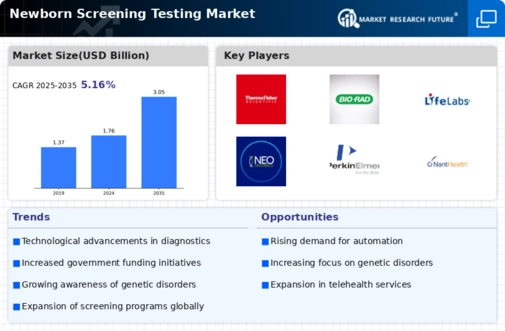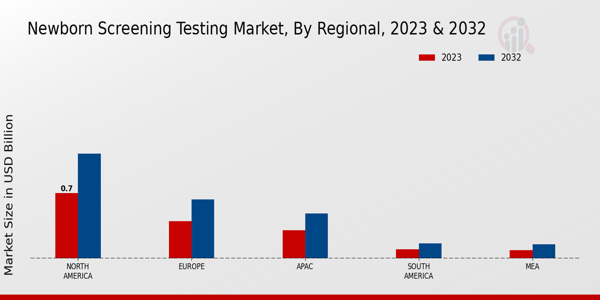Market Growth Projections
The Global Newborn Screening Testing Market Industry is anticipated to experience substantial growth, with projections indicating an increase from 1.76 USD Billion in 2024 to 3.05 USD Billion by 2035. This growth reflects a compound annual growth rate of 5.12% from 2025 to 2035, driven by factors such as technological advancements, government initiatives, and rising awareness among parents. The market's expansion is likely to be supported by ongoing research and development efforts aimed at improving screening methodologies and expanding the range of detectable disorders.
Expansion of Screening Panels
The expansion of newborn screening panels to include a broader range of disorders is influencing the Global Newborn Screening Testing Market Industry. As research uncovers new conditions that can be effectively screened, healthcare systems are increasingly adopting these expanded panels. This trend not only enhances the detection of rare diseases but also aligns with the global push for personalized medicine. The market's growth trajectory appears promising, with projections indicating a rise to 3.05 USD Billion by 2035, as more comprehensive screening options become standard practice.
Growing Awareness Among Parents
The growing awareness among parents regarding the benefits of newborn screening is a significant driver of the Global Newborn Screening Testing Market Industry. Educational campaigns and advocacy from health organizations have led to increased parental demand for screening services. Parents are now more informed about the potential risks associated with undiagnosed congenital disorders, prompting them to seek early testing for their newborns. This heightened awareness is likely to contribute to a compound annual growth rate of 5.12% from 2025 to 2035, as more families prioritize health screenings.
Government Initiatives and Policies
Government initiatives promoting newborn screening programs are pivotal in shaping the Global Newborn Screening Testing Market Industry. Many countries have implemented policies mandating screening for specific disorders, which has led to increased testing rates. For instance, the U.S. Department of Health and Human Services has established guidelines for state-level screening programs, ensuring that all newborns receive necessary tests. This regulatory support not only enhances public health outcomes but also stimulates market growth, as healthcare facilities invest in the required technologies and training.
Rising Prevalence of Congenital Disorders
The increasing prevalence of congenital disorders globally drives the Global Newborn Screening Testing Market Industry. Conditions such as phenylketonuria and cystic fibrosis are being identified at higher rates, necessitating early detection to improve health outcomes. In 2024, the market is projected to reach 1.76 USD Billion, reflecting a growing awareness among healthcare providers and parents regarding the importance of early screening. This trend is likely to continue, as more countries adopt universal screening programs, thereby enhancing the demand for advanced testing technologies.
Technological Advancements in Screening Methods
Technological innovations in newborn screening methods significantly influence the Global Newborn Screening Testing Market Industry. The introduction of next-generation sequencing and tandem mass spectrometry has improved the accuracy and efficiency of tests. These advancements allow for the simultaneous screening of multiple disorders from a single blood sample, which is particularly beneficial in resource-limited settings. As these technologies become more accessible, the market is expected to grow, with a projected value of 3.05 USD Billion by 2035, indicating a robust shift towards more comprehensive screening solutions.





















